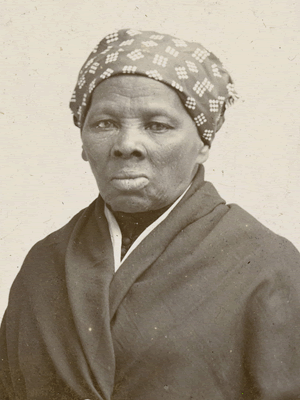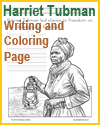Harriet Tubman, born Araminta Ross around 1822 in Dorchester County, Maryland, was a renowned abolitionist, humanitarian, and spy for the Union Army during the American Civil War. Born into slavery, Tubman endured the harsh conditions and brutal treatment common to the enslaved in the antebellum South. Despite these challenges, she developed a deep sense of resilience and an unyielding desire for freedom, making her a stunning example for students of the triumph of the best of humanity in an exceptional individual.
 In 1849, Tubman escaped from slavery, fleeing to Philadelphia. Her escape was perilous, relying on a network of safe houses and secret routes known as the Underground Railroad. Despite the immense danger, Tubman made it to freedom and immediately began planning to rescue her family and others still enslaved.
In 1849, Tubman escaped from slavery, fleeing to Philadelphia. Her escape was perilous, relying on a network of safe houses and secret routes known as the Underground Railroad. Despite the immense danger, Tubman made it to freedom and immediately began planning to rescue her family and others still enslaved.
Tubman returned to the South at least 13 times over the next decade, guiding approximately 70 enslaved people to freedom, earning her the nickname "Moses." She employed various strategies to evade capture, including traveling by night and using disguises. Her success in these missions made her one of the most famous conductors on the Underground Railroad. She never lost a single passenger, a testament to her courage and strategic acumen.
During the Civil War, Tubman served the Union Army in various capacities. She worked as a cook, nurse, and, most notably, as a scout and spy. Her knowledge of the terrain and connections within the African American community proved invaluable. In 1863, she led the Combahee River Raid, which resulted in the liberation of more than 700 enslaved people and disrupted Southern supply lines.
After the war, Tubman continued to be an advocate for civil rights and women's suffrage. She settled in Auburn, New York, where she took in orphans and the elderly, providing care and support. Despite her significant contributions, Tubman struggled with poverty in her later years, a stark contrast to the heroic status she earned.
Harriet Tubman's legacy is one of extraordinary bravery, selflessness, and unyielding dedication to the cause of freedom. Her life's work not only helped dismantle the institution of slavery but also laid the groundwork for future civil rights movements. She remains a symbol of resilience and an inspiration for all who fight against oppression.
When discussing the life of Harriet Tubman with students, discussion questions may include: What gives a person the courage to help others, despite the incredible risk to one's personal safety and comfort? How might students conduct themselves as they attempt to achieve the ideal set by brave Harriet Tubman as she conducted enslaved people along the Underground Railroad to freedom?
|
 In 1849, Tubman escaped from slavery, fleeing to Philadelphia. Her escape was perilous, relying on a network of safe houses and secret routes known as the Underground Railroad. Despite the immense danger, Tubman made it to freedom and immediately began planning to rescue her family and others still enslaved.
In 1849, Tubman escaped from slavery, fleeing to Philadelphia. Her escape was perilous, relying on a network of safe houses and secret routes known as the Underground Railroad. Despite the immense danger, Tubman made it to freedom and immediately began planning to rescue her family and others still enslaved. 








